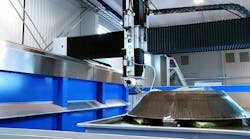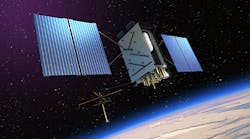Additive manufacturing has proven its worth in the production of specialized designs and products, and now high-tech, high-value components are making it possible to demonstrate the potential for AM in critical high-tech applications. Lockheed Martin reports it has succeeded in printing a large-dimension titanium dome for a satellite fuel tank. The 46-in. diameter (1.16-m.) vessel completed final rounds of quality testing earlier this month at Lockheed Martin Space in Denver, completing a multi-year development program to produce the high-volume, high-pressure tanks to carry fuel aboard satellites.
Lockheed Martin is offering the titanium tank as a standard product option to power its LM 2100 satellite buses. The LM 2100 is a 5,070-14,330 lb. (2,300-6,500 kg), ~12x6 ft. (~3.7x1.8 m) rectangle unit capable for military, civil, and commercial communication service.
“Our largest 3D-printed parts to date show we’re committed to a future where we produce satellites twice as fast and at half the cost,” stated EVP Rick Ambrose of Lockheed Martin Space. He noted the AM operation in Denver reduced the production schedule for the domes by 87%, reducing the total delivery timeline from two years to three months.”
The titanium tank consists of three parts welded together: two 3D-printed domes that serve as caps and a variable-length cylinder as the tank body, formed by standard processes.
The parts were printed on a Sciaky Inc. EBAM 110 machine. It is the largest 3D printer in service for Lockheed at the Denver location. The process draws the part specifications from a CAD program and deposits titanium alloy via wire feedstock in sequential layers, until the near-net-shape part is complete.
Sciaky’s Interlayer Real-time Imaging & Sensing System (IRISS®) is a patented, closed-loop process control system that promotes consistent part geometry, mechanical properties, microstructure, and metal chemistry. Gross deposition rates range from 7 to 25 lbs. (3.18 to 11.34 kg) of metal per hour, depending upon the material and part features.
"Sciaky's EBAM technology is now the world's only large-scale metal 3D-printing process that has qualified applications for land, sea, air, and space," stated company president Scott Phillips.
Satellite fuel tanks must be both strong and lightweight to endure the mechanical strain of launch and decade-long service in the vacuum of space. Titanium is well suited to this, but 4-ft.-diam., 4-in.-thick titanium forgings are expensive to produce and may take a year or more to source. The standard manufacturing techniques also incur material waste of more than 80%, according to Lockheed.
“We self-funded this design and qualification effort as an investment in helping our customers move faster and save costs,” according to Ambrose. “These tanks are part of a total transformation in the way we design and deliver space technology. We’re making great strides in automation, virtual reality design and commonality across our satellite product line.”
Lockheed is building a $350-million operation near Denver to manufacture next-generation satellites, to be completed by 2020.
In the design of the tank, any structural weakness could be disastrous for the satellite mission. So, according to Lockheed Martin, its engineers took pains to guarantee that the 3DP tanks meet (or exceed) NASA-stipulated performance and reliability standards. Engineers and technicians evaluated the structure thoroughly through a series of tests to demonstrate tolerances and repeatability.
Lockheed called its fuel-tank domes "a leap in size for qualified 3D-printed materials," offering for comparison a "toaster-size electronics enclosure" that was largest 3DP part previously qualified for the Advanced Extremely High Frequency satellite program.
Lockheed Martin’s launched the first-ever 3D-printed parts into deep space in 2011, aboard NASA’s Juno spacecraft, and it noted it has produced thousands of AM flight components, tooling and prototypes using various metals and composites.










